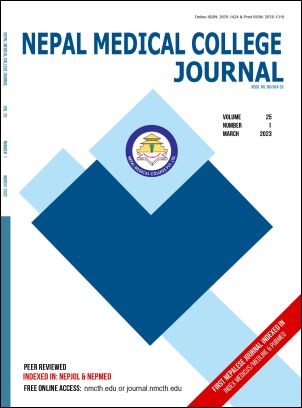Prevalence and molecular characterization of methicillin resistant Staphylococcus aureus (MRSA) and vancomycin resistant Staphylococcus aureus (VRSA) in a tertiary care hospital
DOI:
https://doi.org/10.3126/nmcj.v25i1.53373Keywords:
Staphylococcus aureus, mecA, MRSA, PVL, vanA, VRSA, NepalAbstract
Resistance shown by Staphylococcus aureus to methicillin; mediated by mecA, and vancomycin; mediated by vanA, has led to difficulty in treatment of related infections. Despite reports showing methicillin resistant S. aureus (MRSA) and vancomycin resistant S. aureus (VRSA) in Nepal, and need for their regular surveillance, no study has been conducted on it in our hospital. So, this study is aimed to determine prevalence of MRSA, VRSA and their molecular characterization along with antibiogram. A descriptive cross-sectional study was conducted from August to December, 2022 in Clinical Microbiology Laboratory of NMCTH among S. aureus (n=160) isolated from various clinical specimens after receiving ethical approval from NMC-IRC. AST was done by modified Kirby-Bauer’s disc diffusion method. MRSA and VRSA were detected by cefoxitin disc method and agar dilution method respectively. Inducible clindamycin resistance was detected by D-test. Resistant genes (mecA, PVL, and vanA) were detected using conventional PCR. Prevalence of MRSA was found to be 31.2% (50/160) but none of the isolates were resistant to vancomycin. Total 7 (46.6%) mecA and 7 (46.6%) PVL genes were detected among 15 selected MRSA isolates but vanA was not found. All the MRSA isolates were susceptibile to co-trimoxazole, tigecycline, chloramphenicol, vancomycin, teicoplanin and linezolid. The resistance rate against ciprofloxacin, ofloxacin, and clindamycin was 52.0%, 44.0%, and 68.0% (20.0% iMLSB, 28.0% cMLSB and 16.0% MS-phenotypes) respectively. Prompt implementation of hospital antibiotic policy and AMR Act by government along with regular surveillance of MRSA and VRSA seems essential to contain MRSA infections. Co-trimoxazole could be treatment option against MRSA in our setting, keeping vancomycin in reserve. However, large scale studies are required to establish this conclusion.
Downloads
Downloads
Published
How to Cite
Issue
Section
License
Copyright (c) 2023 Nepal Medical College Journal

This work is licensed under a Creative Commons Attribution 4.0 International License.
This license enables reusers to distribute, remix, adapt, and build upon the material in any medium or format, so long as attribution is given to the creator. The license allows for commercial use.




